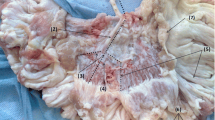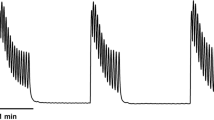Abstract.
Sumatriptan, a 5-HT1B/1D/1F receptor agonist, is used to relieve migraine headache. Sumatriptan contracts some arteries either directly or after modest precontraction with non-serotonergic agonists. Sumatriptan can cause myocardial ischaemia and myocardial infarction. While previous in-vitro studies have shown that sumatriptan has no or only weak contractile activity in human omental arteries, recent clinical studies suggest that sumatriptan may induce mesenteric ischaemia. The aim of this study was to investigate the presence of contractile 5-HT1B receptors in the human mesenteric artery and to establish whether the weak sumatriptan-induced contractions are amplified by precontraction with various contractile substances. The study was performed in organ baths using endothelium-denuded isolated human mesenteric arteries. Sumatriptan induced concentration-dependent contractions in some mesenteric arteries [E max 61±10% of the maximum contraction induced by 80 mM KCl, pD2 (–log10EC50) 6.56±0.20, n=9]. In the other mesenteric arteries, sumatriptan induced only very weak (E max <5%) or no contraction (n=13). GR127935 (3 nM), a selective 5-HT1B receptor antagonist, antagonized sumatriptan-induced contractions insurmountably in sumatriptan-sensitive arteries. When the resting tension of the arterial rings was increased moderately by threshold concentrations (EC10–EC20 of maximum contraction induced by 80 mM KCl) with the non-5-HT receptor agonists phenylephrine (10–100 nM), histamine (100 nM–1 µM) or the depolarizing agent KCl (4–10 mM), 5-HT1B receptor-mediated responses were amplified in sumatriptan-insensitive arteries (with phenylephrine E max 82±17%, pD2 6.64±0.20, n=7; with histamine E max 107±26%, pD2 6.16±0.14, n=6; with KCl E max 78±16%, pD2 6.45±0.15, n=7). These results show that sumatriptan induced concentration-dependent contractions in sumatriptan-sensitive mesenteric arteries and that 5-HT1B receptors were present and active in these vessels. However, in sumatriptan-insensitive arteries, precontraction is required for sumatriptan to induce concentration-dependent contractions. These findings suggest that sumatriptan may induce ischaemia in human mesenteric vasculature directly or in the presence of precontractile risk factors.
Similar content being viewed by others
Author information
Authors and Affiliations
Additional information
Electronic Publication
Rights and permissions
About this article
Cite this article
Gul, H., Yildiz, O. Amplification of sumatriptan-induced contractions with phenylephrine, histamine and KCl in the isolated human mesenteric artery: in-vitro evidence for sumatriptan-induced mesenteric ischaemia. Naunyn-Schmiedeberg's Arch Pharmacol 366, 254–261 (2002). https://doi.org/10.1007/s00210-002-0587-1
Received:
Accepted:
Issue Date:
DOI: https://doi.org/10.1007/s00210-002-0587-1




